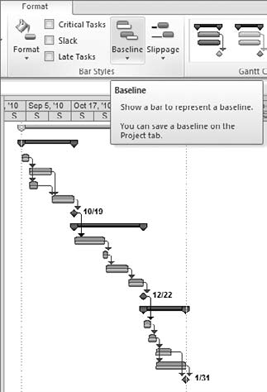2. Formatting the Gantt Chart to Display the Baseline
Although the default Gantt Chart view doesn't
display the baseline, you can reformat the view to display the baseline
at any time. One quick way to do this uses the Format tab; follow these
steps (see Figure 3):
In the Gantt Chart view, go to Format tab => Bar Styles group.
Click the Baseline drop-down list, and select Baseline (the first option in the list).
|
Over the years, I've worked with many clients to
customize solutions using Microsoft Project. One of the key components
to a successful implementation is to customize the tool to support the
client's project-management processes, which include not only planning
but also tracking and updating.
The solution typically includes developing a custom
view for tracking and updating to support the project's monitoring and
control stage. This includes adding custom fields such as the Task
Finish Status indicator and the Needs Updating indicator.
The custom view also includes a custom tracking
table that's based on the Variance table but modified to include %
Complete and the two custom fields just described. The custom view also
includes custom bar formatting to display the baseline in the Gantt bar
area as well as custom gridlines to display both the current date in
red and the project start date in blue.
|
This is similar to the Tracking Gantt view, except
that you don't have to switch views to display the baseline. The
baseline bars are the bottom bars, which are grey; they will stay in
place as the current plan is adjusted. Having the baseline bars
displayed in the Gantt chart makes it more effective for visually
tracking and identifying variances.
You can add any of the baseline fields to any table at any time.
